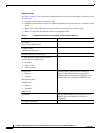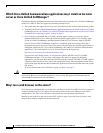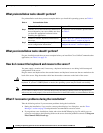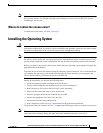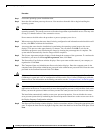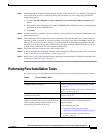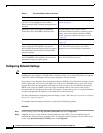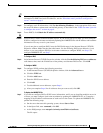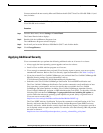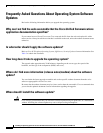
20
Installing the Operating System on the Cisco Unified Communications Server, Versions 2000.4.3 and 2000.4.3a
OL-10221-02
Performing Post-Installation Tasks
Configuring Network Settings
Tip Cisco recommends that you configure static IP information, which ensures that the Cisco Unified
CallManager server obtains a fixed IP address. With this choice, Cisco Unified IP Phones can register
with Cisco Unified CallManager when you plug the phones into the network.
If you choose to use Dynamic Host Configuration Protocol (DHCP), Cisco Technical Assistance Center
(TAC) requires that you reserve an IP address for each server in the DHCP server scope. This action
prevents the release or reassignment of IP addresses. If you do not reserve IP addresses through the
DHCP server scope, the DHCP server may assign a different address to the server if the server is
disconnected from, and then reconnected to, the network. To return the server to its original IP address,
you must reprogram the IP addresses of the other devices on the network.
For other information on configuring network settings, see the “What data must I provide to configure
the server?” section on page 9.
To configure network settings on the server, perform the following procedure:
Procedure
Step 1 On the desktop, right click My Network Connections and choose Properties.
Step 2 Although the server comes with two Network Interface Cards (NIC), Cisco recommends that you
configure the network settings on the first NIC. To configure network settings on the first NIC on the
server, click Internet Protocol (TCP/IP); then, click Properties.
If you plan to install Cisco CallManager Release
3.3(2) or 3.3(3), uninstall the non-security
Microsoft hotfix 831877 that the operating system
includes.
See the “Uninstalling Microsoft Hotfix 831877”
section on page 22.
Subscribe to the Cisco Unified CallManager
Notification Tool and PSIRT notification tool.
This task enables you to receive e-mail
notification whenever new fixes, operating system
updates, and service releases become available.
See the “Applying Additional Security” section
on page 23.
Increase the security on your server. See the “Applying Additional Security” section
on page 23.
If your hardware supports network teaming (HP
only), enable the Cisco Media Convergence
Server (MCS) Network Teaming Driver to support
the functionality for the failover, fault-tolerant
network adapters.
Refer to Using the Cisco Media Convergence
Server Network Teaming Driver for a list of
supported servers and installation information.
Configure the speed and duplex of your network
card to 1000/Full if the hardware on your server
and network supports gigabit speed.
Refer to Using the Cisco Media Convergence
Server Network Teaming Driver.
Table 5 Post-Installation Tasks (continued)
Task Notes



